As another Women’s Super League season is about to kick off, the spotlight inevitably falls on the well-known stars who grace the pitch each week. The league is home to some of the biggest names in women’s football, such as Sam Kerr, Vivianne Miedema and Khadija Shaw, to name a few.
The global coverage of the 2023 FIFA Women’s World Cup opened the door to more people taking an interest in women’s football and brought a bigger audience to the sport. Several new fans will most likely be tuning into the WSL for the first time, aware of the big names such as Ella Toone, Alessia Russo and Mille Bright but unaware of some immensely talented players who fly under the radar.
This tactical analysis will highlight five lesser-known players who we believe will significantly impact the league this season.
Kirsty Hanson – Aston Villa
The first player we will look at in this scout report is probably the most well-known from this list. The 25-year-old spent four seasons at Manchester United, playing for the Red Devils women’s team since their formation in 2018.
However, with it looking increasingly unlikely that she would receive adequate playing time last season, Hanson agreed a loan deal with Aston Villa. The Scottish international can reflect on this as one of her best decisions. A regular in Carla Ward’s starting lineup, Hanson became a key player as Villa made incredible strides forward with their fifth-place finish. Ward was suitably impressed that she made Hanson’s transfer permanent over the summer.
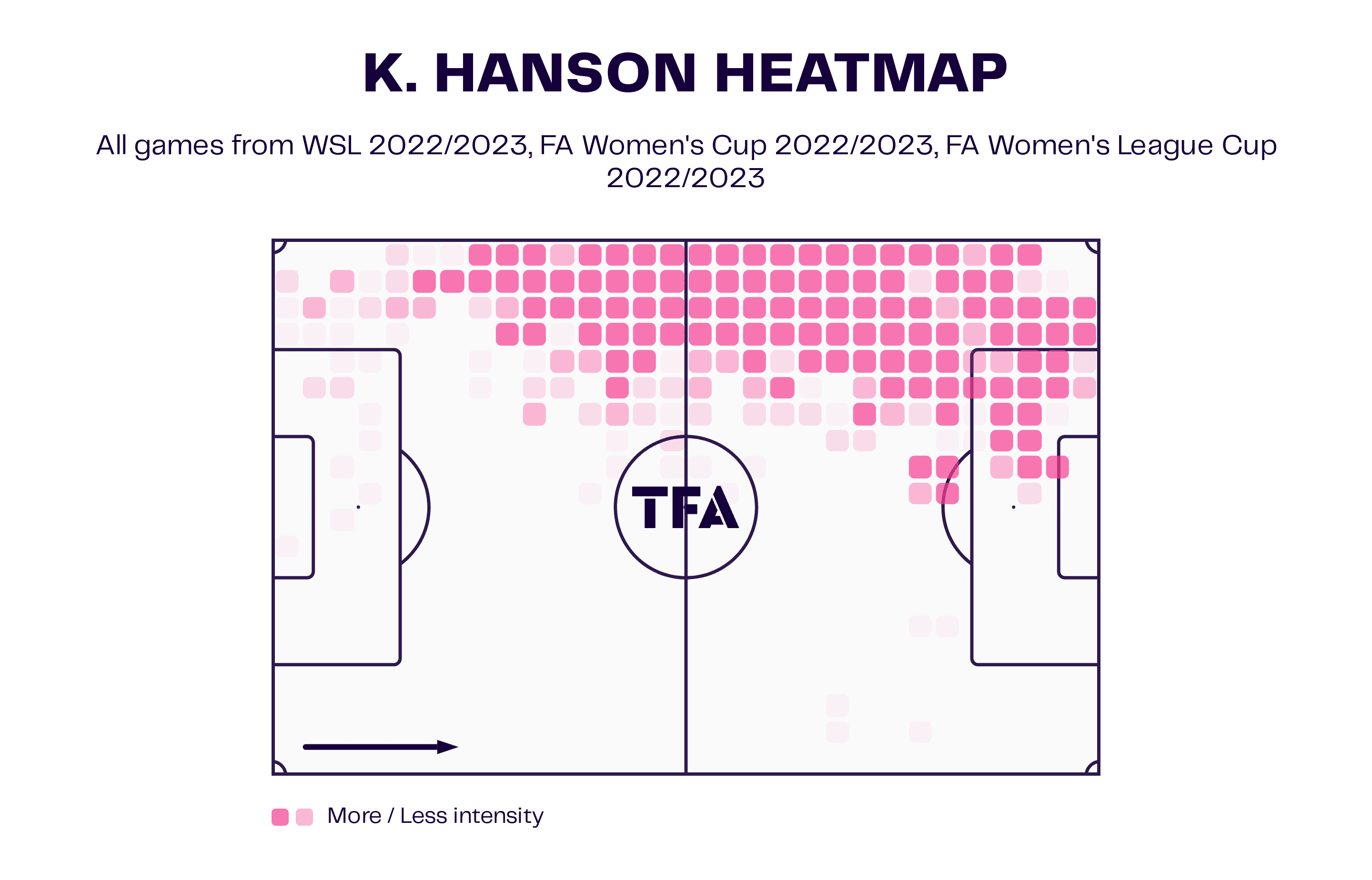
Primarily playing on the left wing of a very fluid 4-3-3, Hanson provides the width that allows Villa to stretch the pitch, as seen from the heatmap above. By staying quite wide, she forces the opposing full-back to make a decision: either follow her, leaving space in the central areas for the likes of Kenza Dali and Jordan Nobbs to exploit, or stay more central, allowing Hanson room to exploit the flanks.
However, she has the freedom to drift infield should she desire, as Carla Ward tends to adopt a free-flowing tactical style. Attacking players, in particular, can rotate positions to create space for others.
Hanson is a tricky winger who loves to carry the ball, averaging 8.74 dribbles per 90 last season, second only to Manchester City’s Lauren Hemp when comparing wingers in the WSL. She is physically very strong, often allowing her to shield the ball and use her body orientation to ensure the opponent cannot regain possession.
Additionally, the Aston Villa player is a very progressive player who looks to have a real impact on the team’s attacking play. She averaged 4.52 progressive passes per 90 last season and 3.38 progressive runs per 90. Hanson averaged 4.37 touches in the opposition penalty area per 90 last season, which is significantly fewer than the likes of Hemp or Arsenal’s Caitlin Foord, who both averaged over 7 per 90.
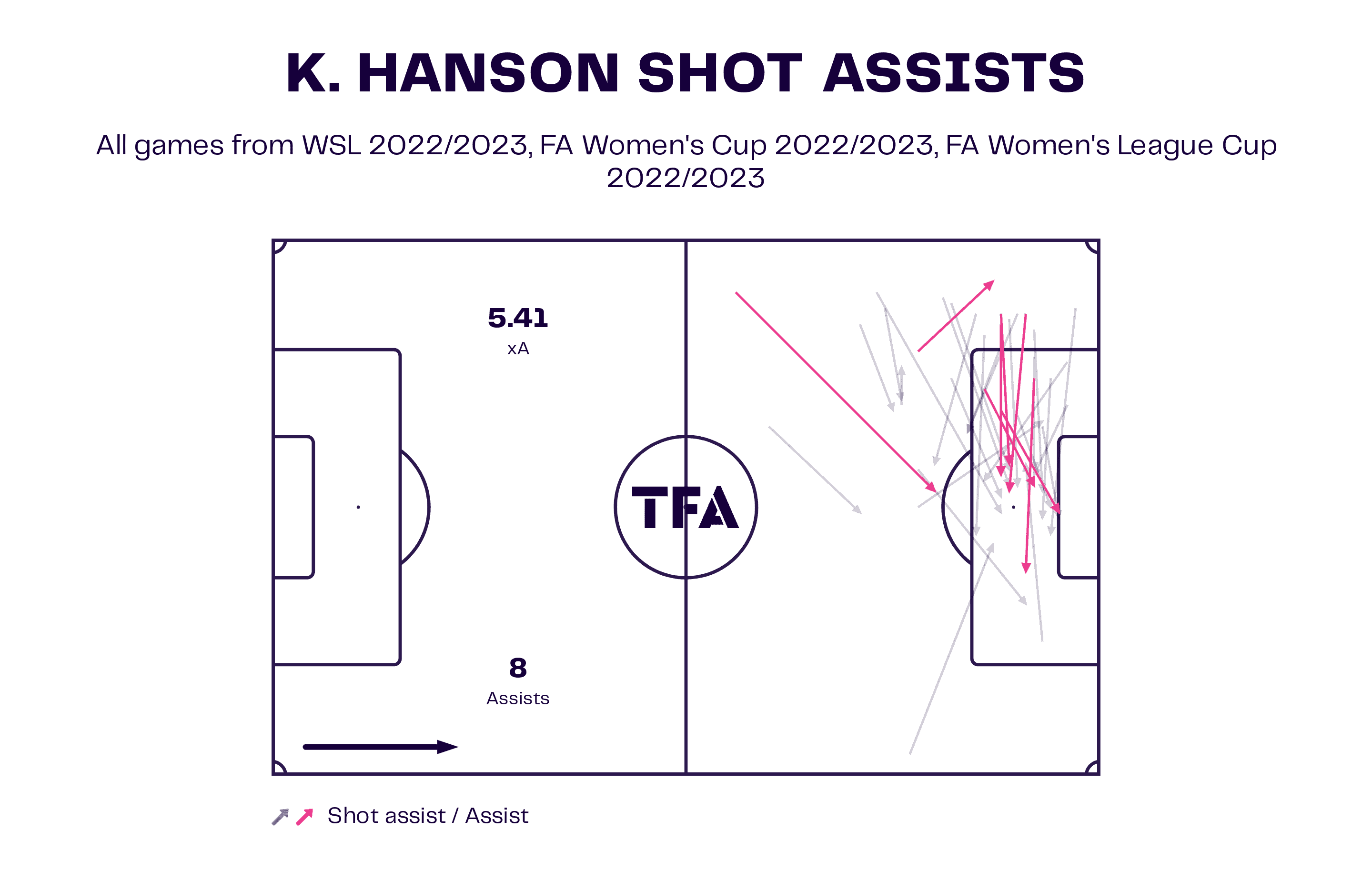
Kirsty Hanson aided Villa’s cause with eight goals and eight assists last season. The data visual above shows us where her assists came from on the pitch. As we would expect, the majority were crosses or passes coming into the penalty area from the left wing. The most likely target was Rachel Daly, who was in clinical form as she led the WSL goalscoring charts last season, scoring 22 goals.
We can see that her eight assists came from an xA of 5.41, which suggests that she is capable of playing accurate low-percentage passes. Additionally, this could infer that Villa’s fellow attackers scored from unlikely goalscoring positions or that the opposition defenders perhaps didn’t do as well as expected in their defensive actions.

This is an example of one of Hanson’s assists. She receives the ball out wide and uses her quick feet to work enough space to fizz a cross into the penalty area, where a Villa attacker is waiting to get on the end of it. On this specific occasion, Daly missed it, and it was down to Alisha Lehmann to turn the ball goalwards.
Hanson averaged 4.87 crosses per 90 last season, which places her in the top five when comparing WSL wingers (with over 900 minutes played). However, her crossing accuracy rating was 30.61%; this is perhaps something that she should look to improve as it would most likely increase Villa’s goal output if she could play more accurate crosses.
As per the heatmap above, Hanson covers a fair amount of ground defensively. She is more than willing to track back and play her part. The Scot often uses her physical strength to help her regain possession, engaging in 9.39 defensive duels per 90 last season, with a success rate of 64.02%. Furthermore, she averaged 6.06 interceptions per 90, using her excellent ability to read the game to ensure that she was in the right place at the right time to incept the opposition pass.
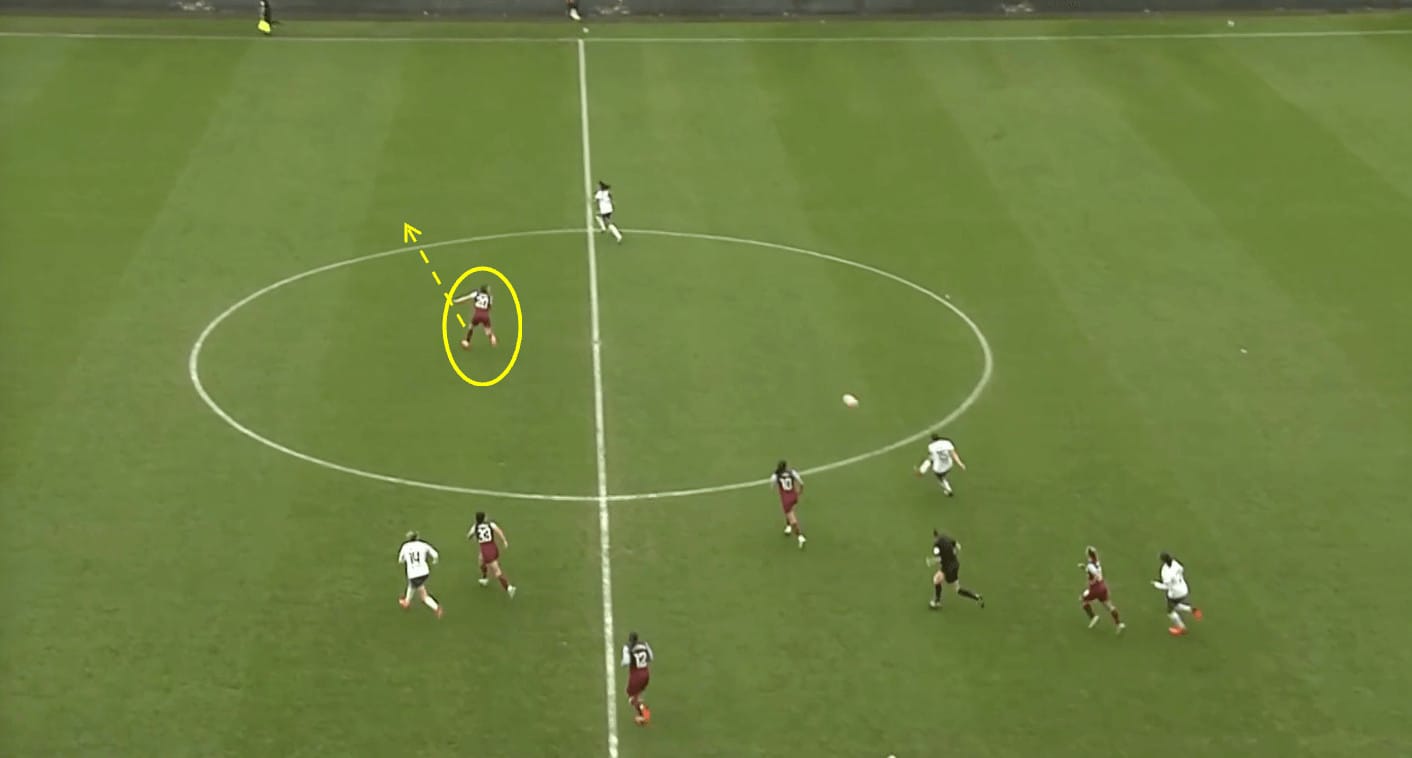

This is demonstrative of Hanson’s excellent defensive positioning and abilities in 1v1s. She recognises that Aston Villa are about to be caught on the counter and sprints across to the opponent. Hanson doesn’t panic, stays calm and carefully gets her foot to the ball to win it back. She is then able to use that acceleration to launch a counterattack.
Karen Holmgaard – Everton
Karen Holmgaard has proven to be something of an astute signing for Everton since she put pen to paper with The Toffees ahead of the 2022/23 season. The Danish midfielder made her professional debut for Fortuna Hjørring in 2017 and went on to make over 60 appearances before moving to Turbine Potsdam. Following a season in Germany, Karen Holmgaard and her twin sister Sara opted to reunite with former Fortuna manager Brian Sørensen at Everton.
Sørensen mostly set his team up in a 3-4-3 or 4-3-3 with Holmgaard as a central or defensive midfielder. One of the critical aspects of the Danish midfielder’s play is how reliable she is in possession. The Dane averaged 47.6 passes per 90, with an accuracy rating of 85.39%. Moreover, she averaged 7.29 passes to the final third per 90, with an accuracy of 72.22% and 7.76 progressive passes per 90; these statistics placed her amongst the top ten in terms of passing metrics for midfielders in the WSL last season.
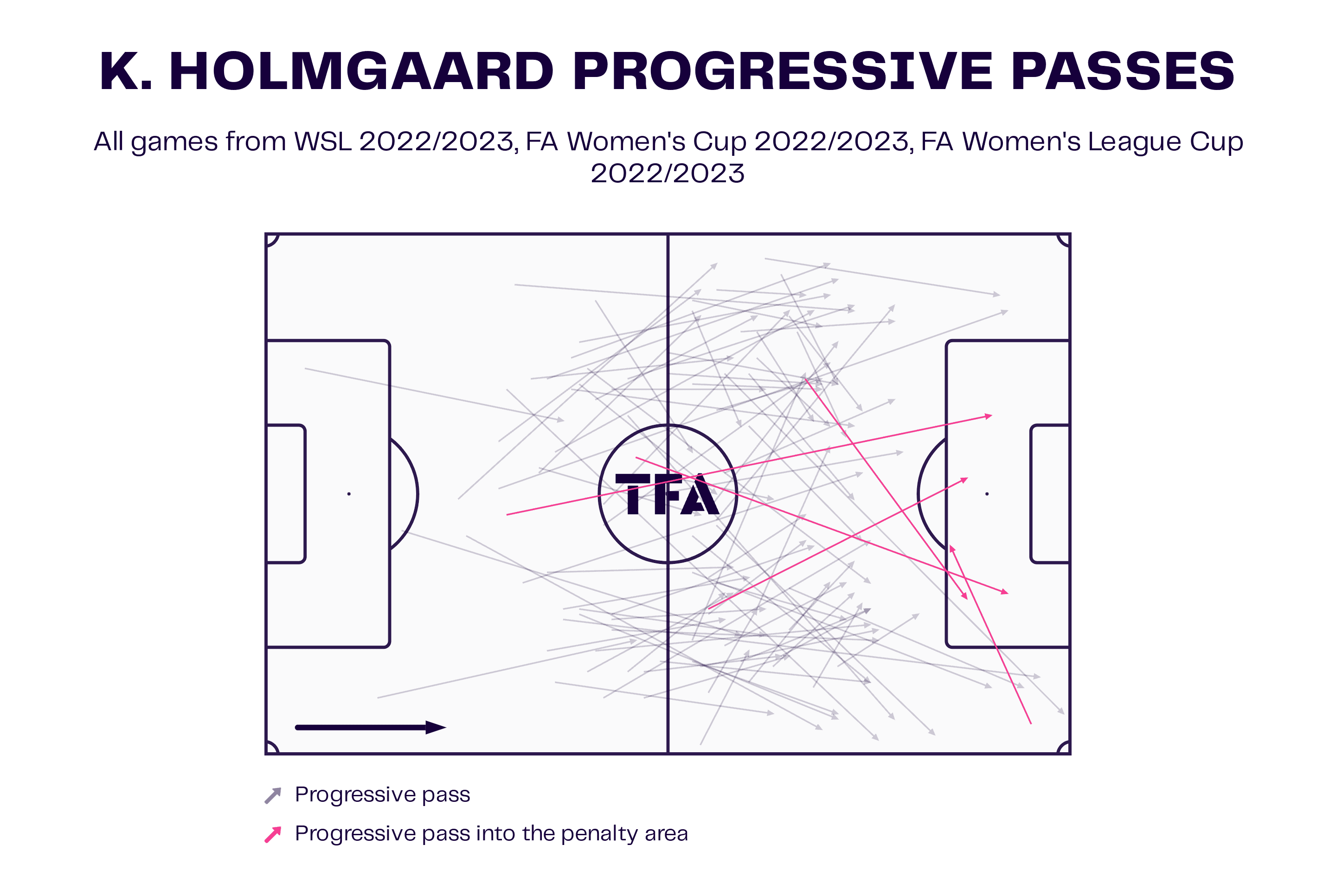
The data visual demonstrates where on the pitch Holmgaard’s progressive passes occurred. We can see that she often looked to play the ball out to the wide areas where either wing-backs or wide forwards would be waiting. Her precise passing skills can act as the fulcrum of the Everton team’s playmaking. Holmgaard is able to dictate the tempo of the game by distributing the ball effectively from deep positions. Plus, her ability to intelligently hold her position when in the rest defence structure provides the likes of Hannah Bennison the freedom to get forward and contribute more effectively to the attack.
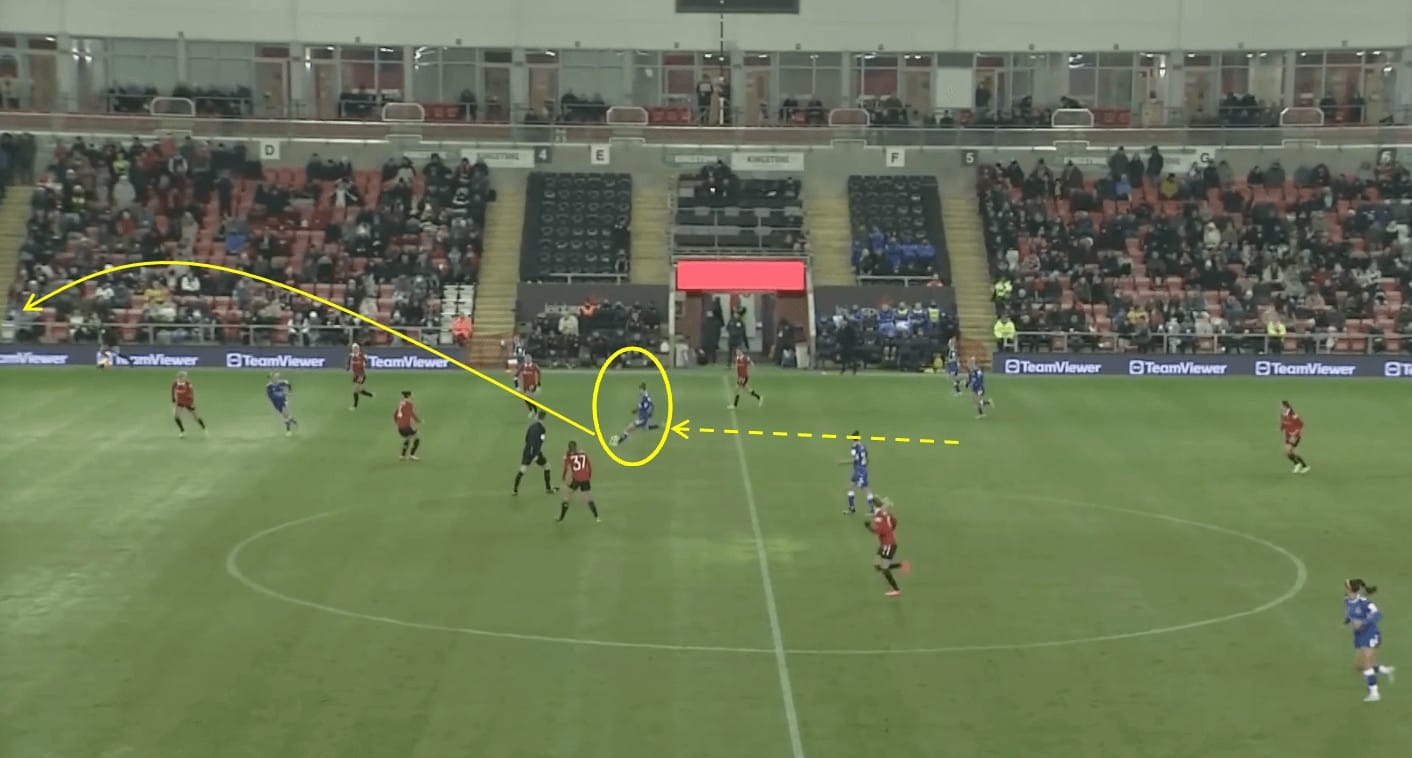
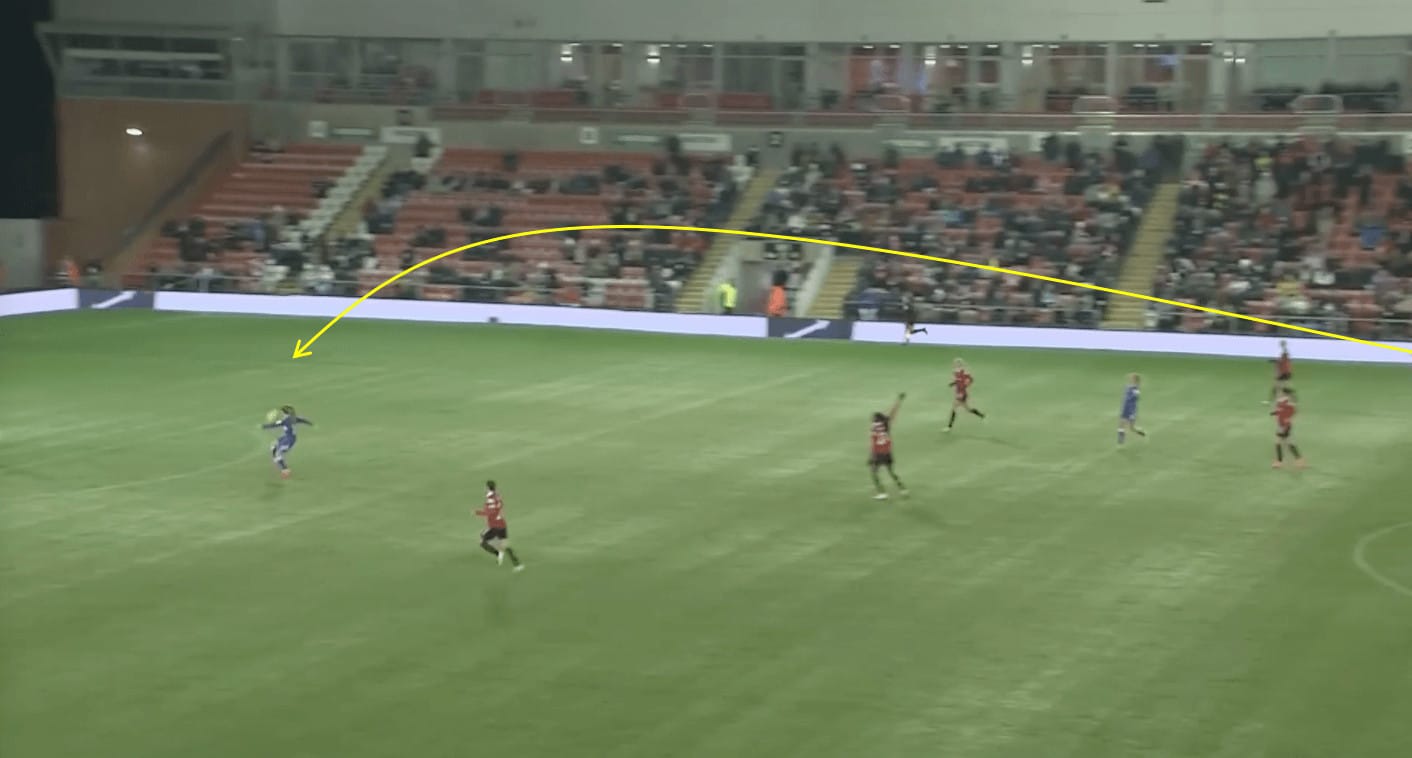
Here, we can see Manchester United learn the hard way that if you allow Karen Holmgaard that much space, she will pick a pass out accurately. The Dane plays a beautiful long pass into the path of Jess Park, who on this occasion was offside, but it served as a warning to Man United of just what she is capable of when given time and space.
Furthermore, her passing ability is also valuable during transition phases. As she is calm and composed on the ball, she can retain possession under pressure, reducing the risk of turnovers in dangerous areas of the field. Plus, she can accurately distribute the ball during transitions from defence to attack, which propels Everton forward with much more attacking intent.
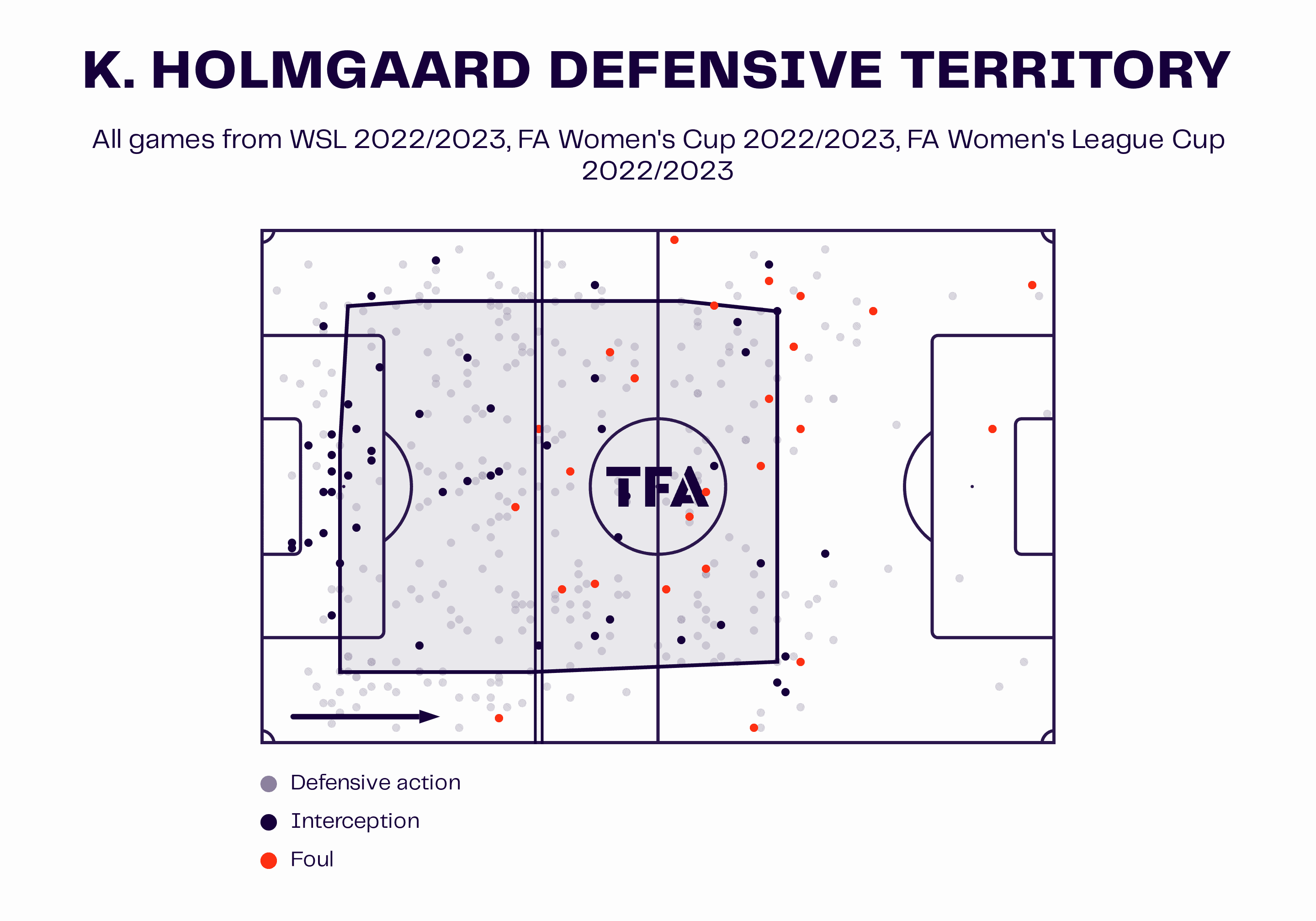
The Everton midfielder’s work during the defensive phase is also incredibly valuable. During last season, Holmgaard averaged 8.03 defensive duels per 90, with a success rate of 64.71%. Plus, she averaged 5.27 interceptions per 90, alongside teammate Clare Wheeler’s 5.37 per 90; these were vital when Everton were defending.
Moreover, the data visual shows us where Holmgaard’s defensive actions took place on the pitch. Sørensen’s defensive tactics centre around his players being intelligent in their 1v1s and closing off passing lanes, allowing time for the remaining Everton players to adopt their defensive structure.
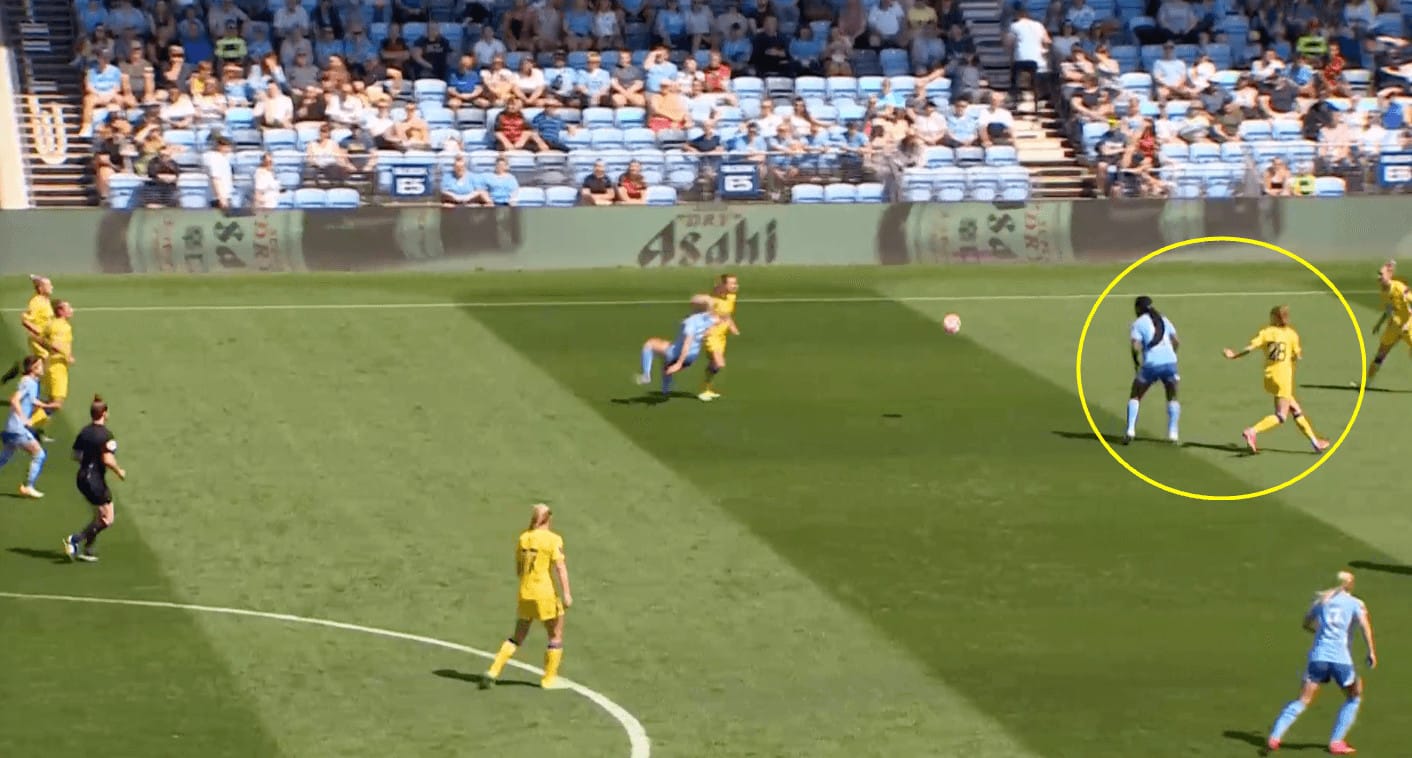
Here, we can see Holmgaard sticking close to Bunny Shaw. She is incredibly astute at tracking the player she is marking and reads the game so well. Once the ball lands at Shaw’s feet, Holmgaard springs into action and presses Shaw, and she can get her foot in and quickly regain possession for Everton.
Holmgaard’s mobility enables her to close down opposing players, limit their passing lanes, and attempt to win back possession for the team. We can also see from the data that she engages in some defensive actions in the opposition half. Last season, she averaged 11.62 recoveries per 90, with 30.6% in the attacking half. This is hugely beneficial to limiting the opposition’s counterattacks and allowing Everton to sustain their attacking pressure.
Janina Leitzig – Leicester City
Leicester City were all but relegated when Janina Leitzing joined on loan in January 2023. The Foxes were rock bottom of the WSL table without a single point to their name by the time the winter break rolled around. The club also haemorrhaged goals at an alarming rate, conceding 29 goals by Christmas. Lydia Bedford left her post as manager, and in came Willie Kirk, charged with the task of turning things around.
Recognising that if Leicester were going to have even the slimmest chance of survival, they needed to improve defensively, including the goalkeeper. Leitzig signed on loan from Bayern Munich and was integral to the team avoiding relegation. Her impressive performances caught the eye of Manchester United, who expressed an interest in signing the 24-year-old over the summer. However, Leitzig opted to make her move to Leicester permanent though, a massive boost to Willie Kirk’s side ahead of the new season.
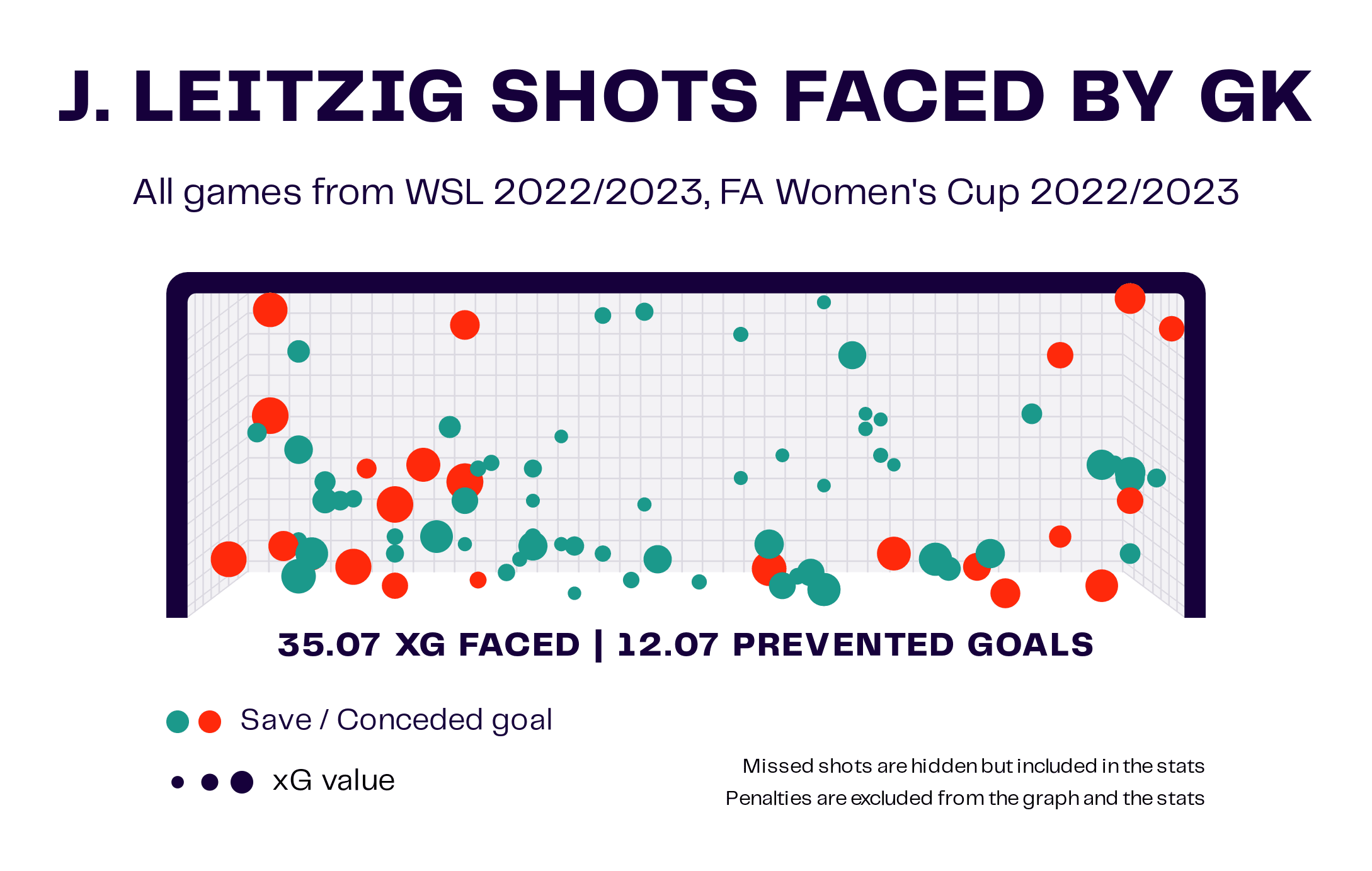
The best way to analyse the impact of a goalkeeper is to look at the number of goals they prevent. From the data visual, we can see that Leitzig faced an xG of 35.07 in all competitions and, amazingly, conceded 12.07 goals less than we would expect – 10.37 in the WSL. The Leicester City goalkeeper faced an average of 6.17 shots per 90, which generated an xGA of 2.26 per 90. In answer to the shots she faced, Leitzig produced a save rate of 74.73%, which ranked her fourth in the league, behind Mary Earps, Ann-Katrin Berger and Manuela Zinsberger.
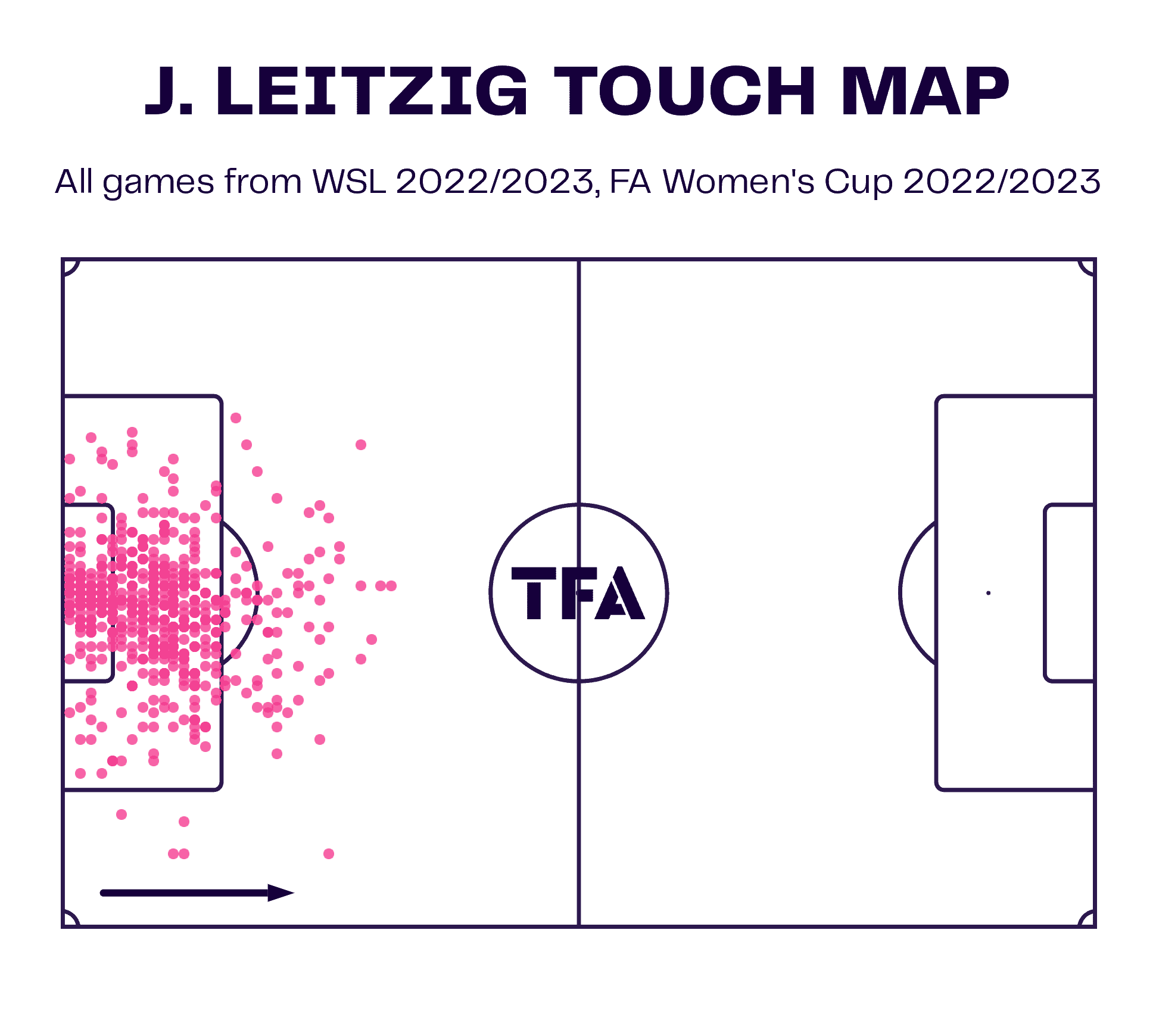
One of the most significant changes Leitzig brought to the Foxes was her dynamic approach to goalkeeping. Leitzig is fearless and plays on the front foot, willing to come out to collect the ball whenever possible. The German shot-stopper averaged 2.31 exits per 90 and 0.75 aerial duels per 90.
By coming off her line to collect crosses, through balls, or loose balls in the penalty area, Janina Leitzig reduces the goalscoring opportunities for the opposing team. This proactive approach can prevent dangerous situations from developing and alleviate pressure on the Leicester City defence. By intercepting passes or clearing long balls before they reach the intended target, she disrupts the flow of the opponent’s offence and can even initiate a counterattack for her team.
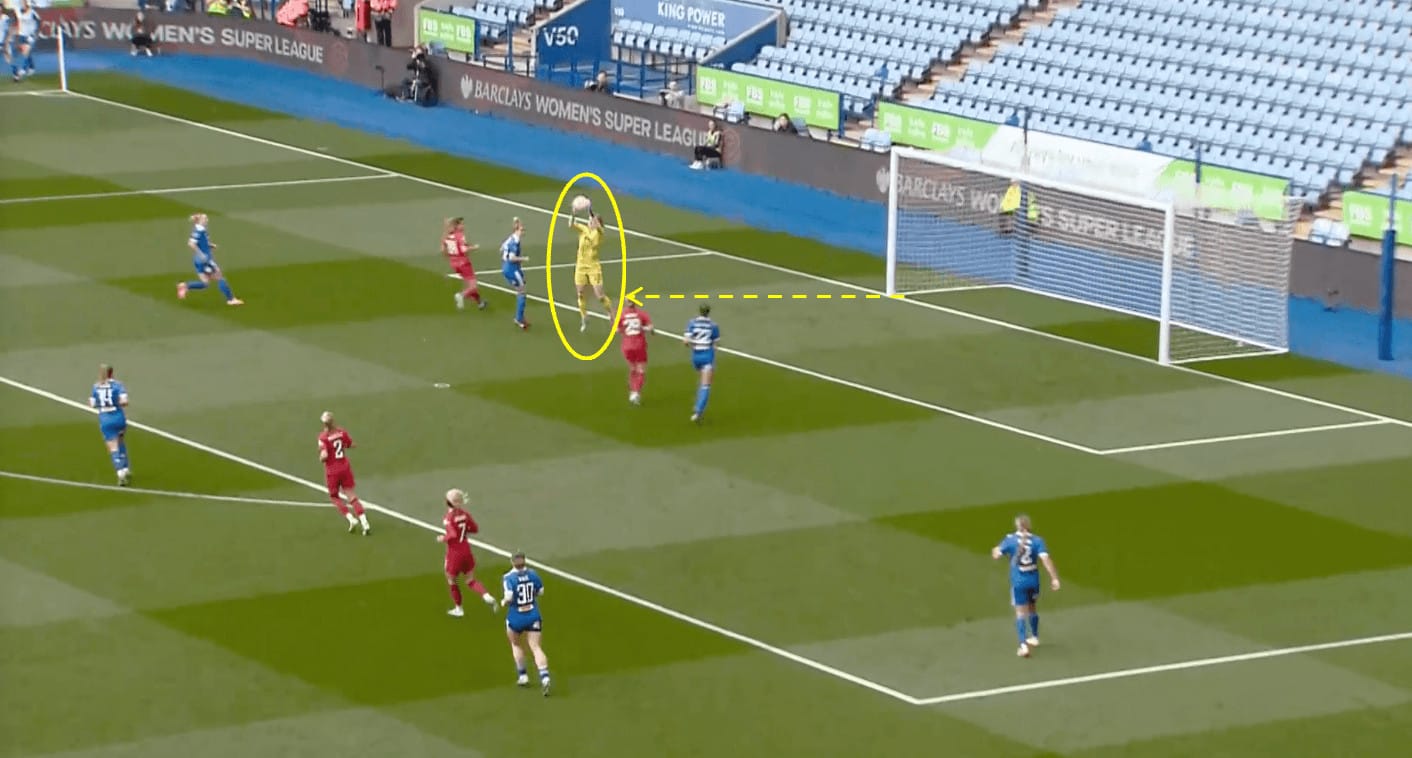
The image above shows Leitzig confidently coming off her line and leaving her six-yard area to claim the ball from a high cross. She watches the ball all the way and communicates effectively with the defenders. She has a very good jumping reach that allows her to claim the ball while still relatively high in the air.
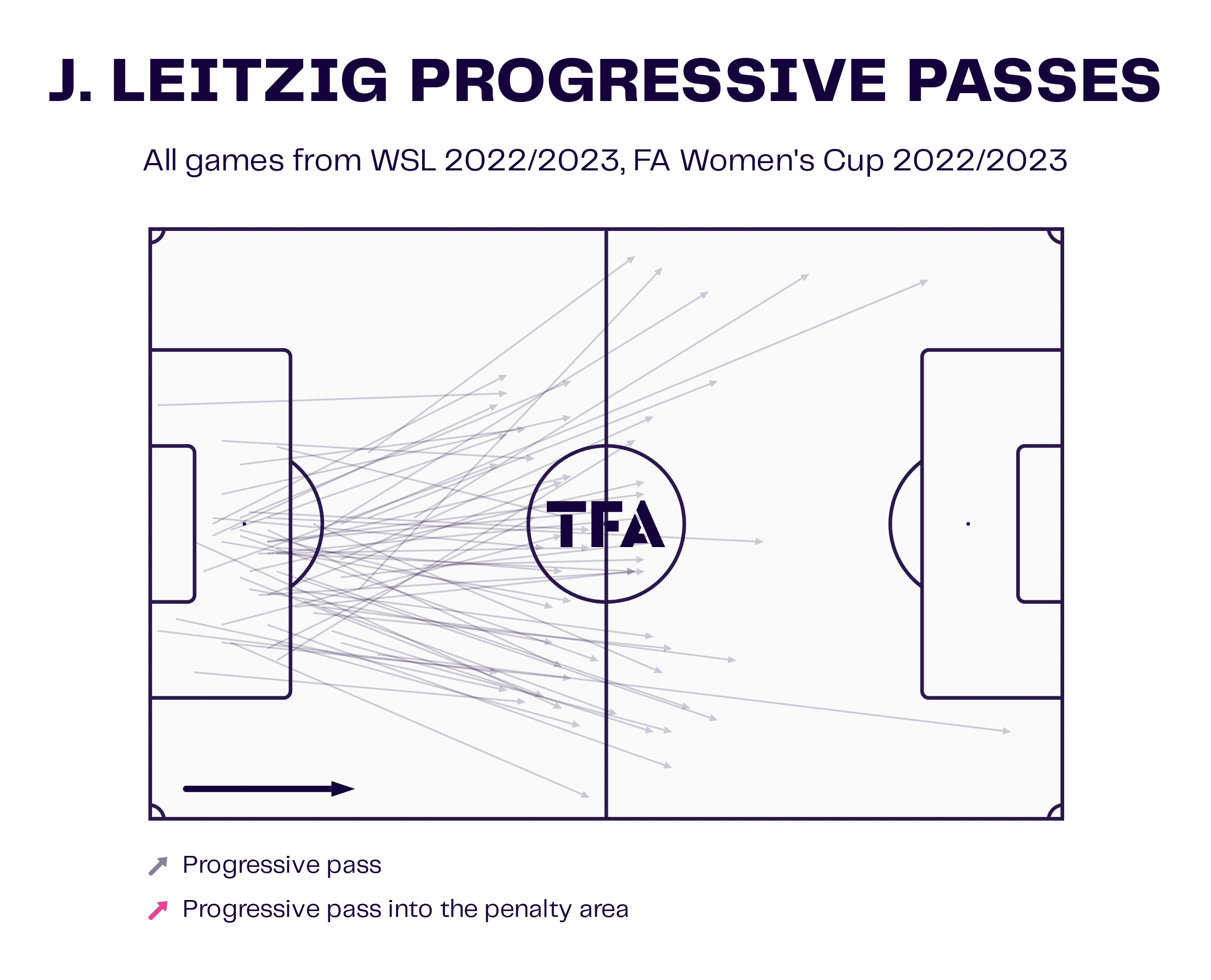
Furthermore, Leitzig’s distribution has benefited Leicester greatly. She averaged 22.99 passes per 90, which is not huge, but she was quite reliable, with an accuracy rating of 81.42%. The standout element of Leitzig’s passing is her progressive passes, which can be seen in the visual above. She averaged 7.19 progressive passes per 90 with an accuracy rating of 52.83%.
Her ability to accurately distribute the ball over long distances can help Leicester initiate quick counterattacks or build possession-based attacks from the back. This dimension adds much more unpredictability to their play, as it means opponents must account for the goalkeeper’s distribution ability to ensure they are not caught out in transition phases.
Risa Shimizu – West Ham
Japanese international Risa Shimizu brought a wealth of experience with her when she put pen to paper for West Ham United. Having made over 160 appearances for Tokyo, Verdy Beleza, the right-back, has been an astute signing for the Hammers.
Although West Ham won’t be too happy with their 2022/23 campaign overall as they finished down in eighth place, compared to the previous season’s sixth place finish, Shimizu was one of their better players last season, and she went on to put in some good performances for Japan at the 2023 Women’s World Cup.
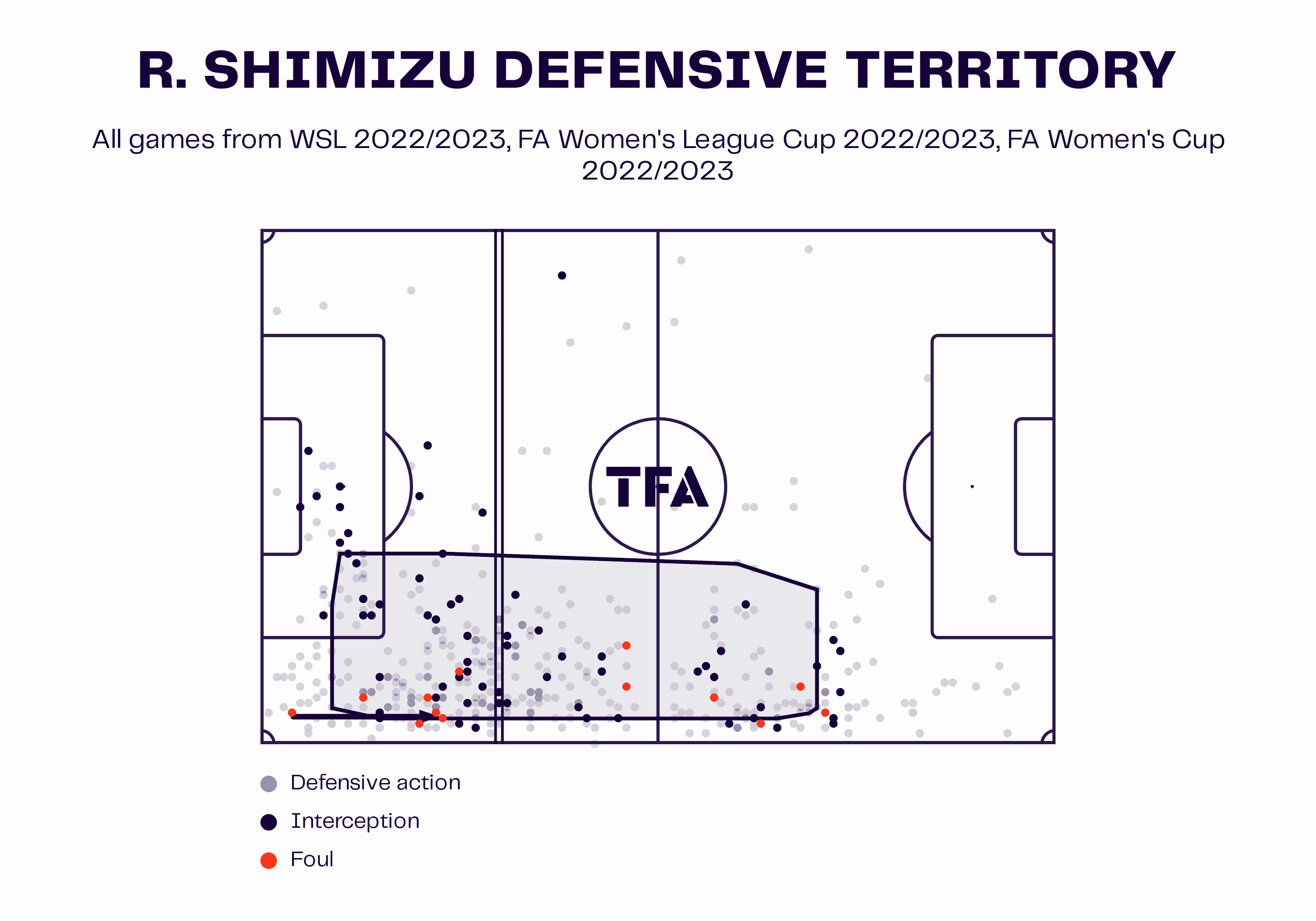
Shimizu is well known for her defensive tenacity and aggressive style of play out of possession. The visual demonstrates her defensive actions on the pitch during the 2022/23 campaign. We can see that the area in which she performed these actions is quite large; Shimizu is a player who likes to press high when given the opportunity. She frequently looks to disrupt the opponent’s attacking rhythm by closing them down and attempting to cut off passing lanes or force turnovers.
The West Ham right-back averaged 4.95 interceptions per 90 last season and engaged in 6.97 defensive duels per 90 with a success rate of 63.58%. These figures represent some defensively solid statistics when considering the club’s struggles last season.
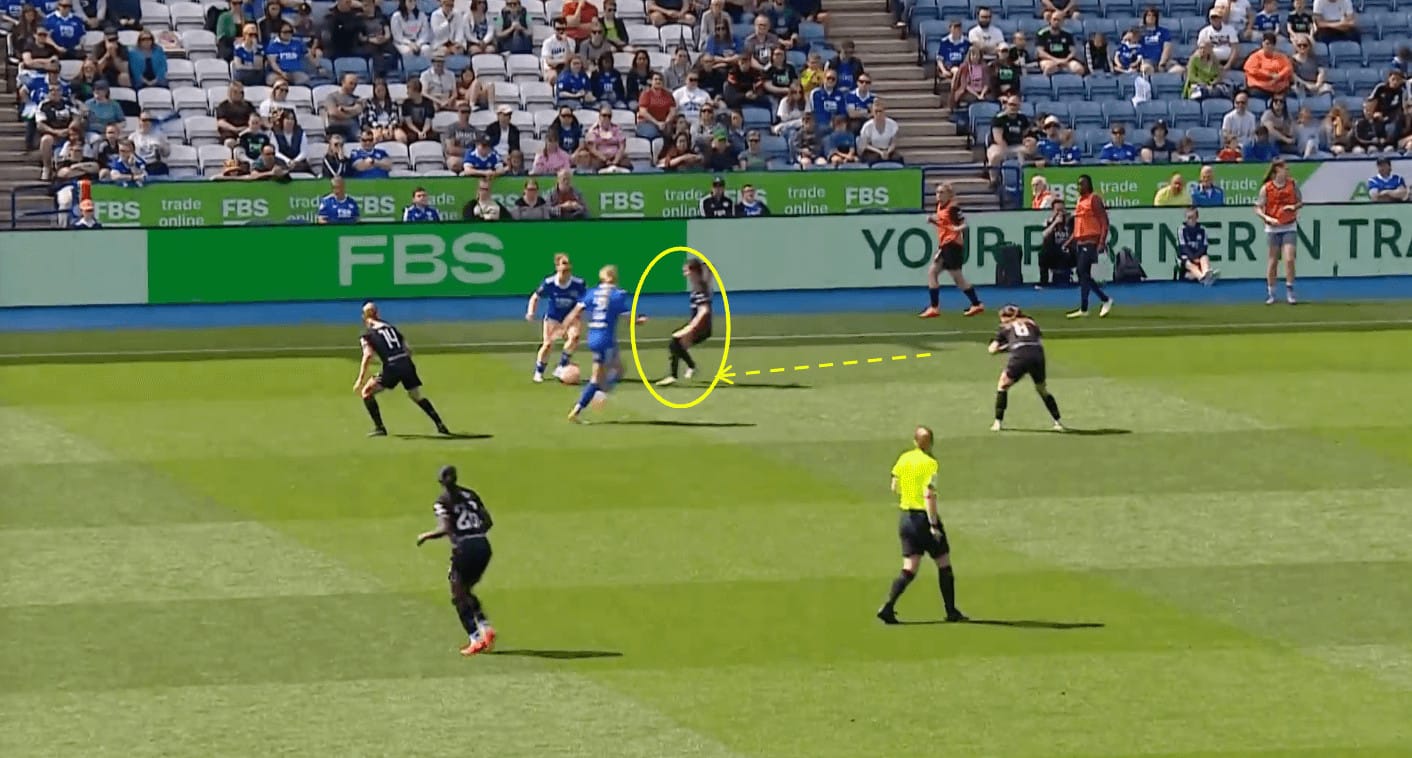
Risa Shimizu’s tenacity is on display here. As soon as her opponent receives the pass, Shimizu closes her down. This limits the options for the Leicester City player and allows the West Ham defender to regain possession and play a pass forward.
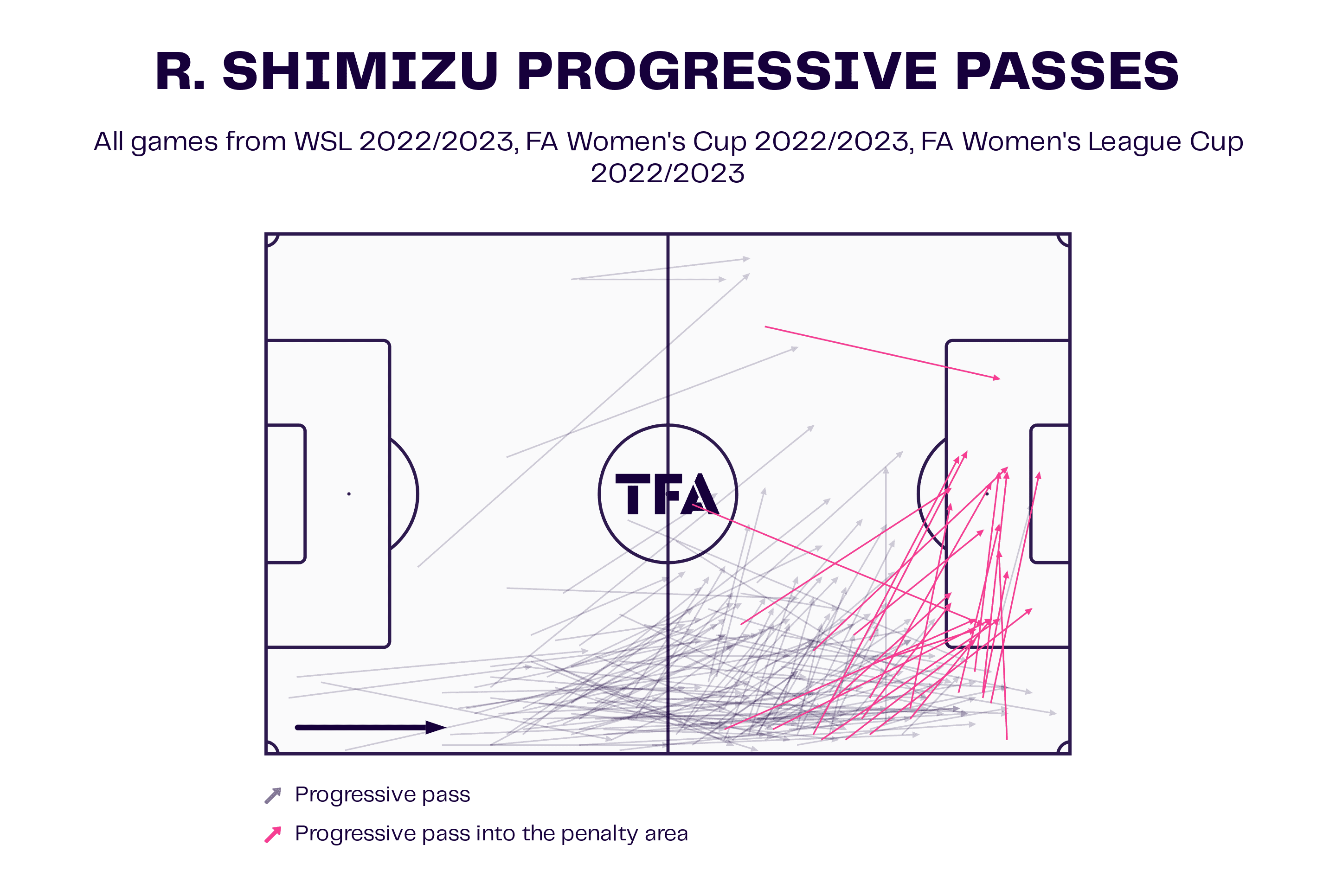
Shimizu also brought her progressive style of play to West Ham. Although she didn’t see too much of the ball, averaging a meagre 33.06 passes per 90, 15.54 were played forward. The Japan international played 9.12 progressive passes per 90; the visualisation above depicts where these passes occurred.
We can see that her progressive passes were vital in helping the team advance up the pitch. Additionally, her ability to play these passes into the opposition penalty area adds a level of dynamism to the West Ham attack.
However, it is worth noting that Shimizu failed to register a single assist last season, from an xA of 1.26, which indicates that despite her progressive passing, she was not always picking out teammates in goalscoring positions. The West Ham attackers struggled to find the back of the net from the passes they received.
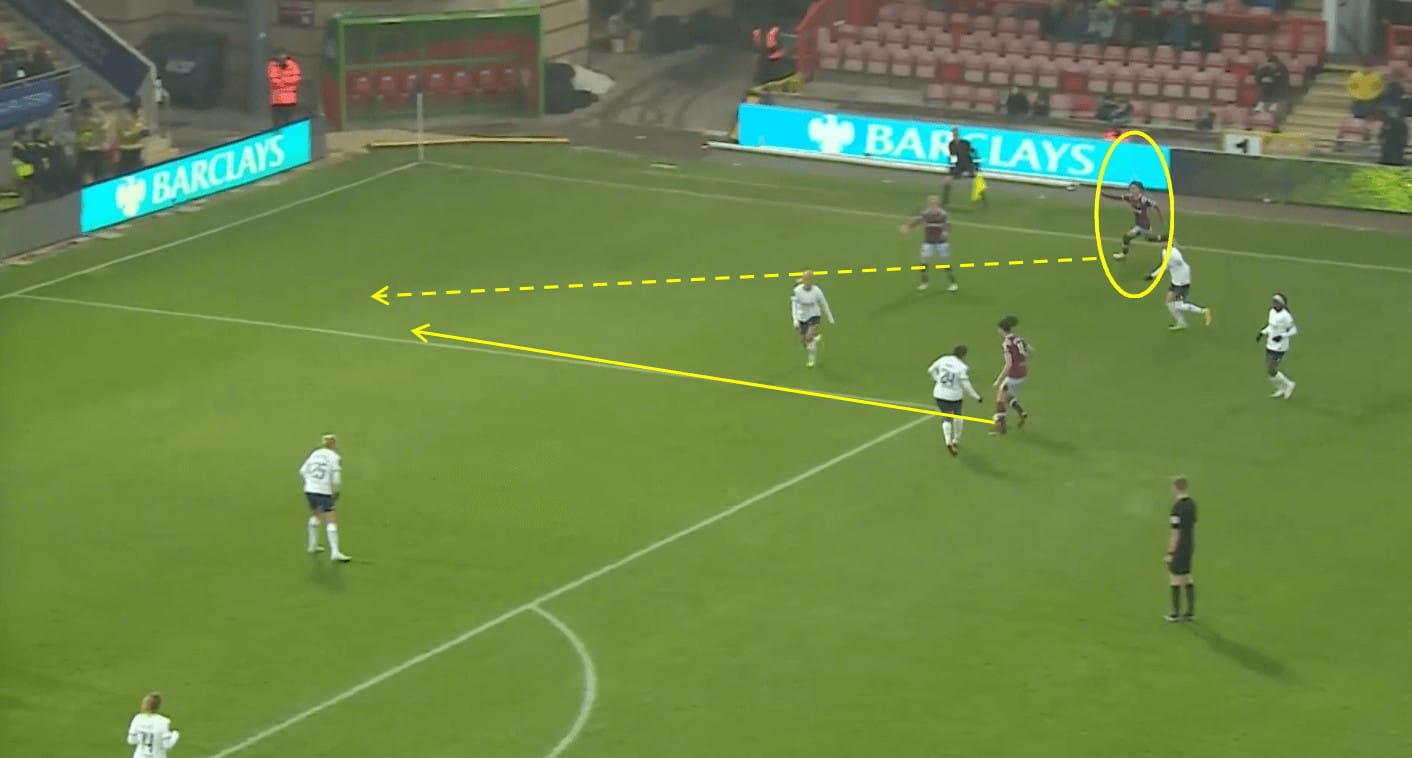
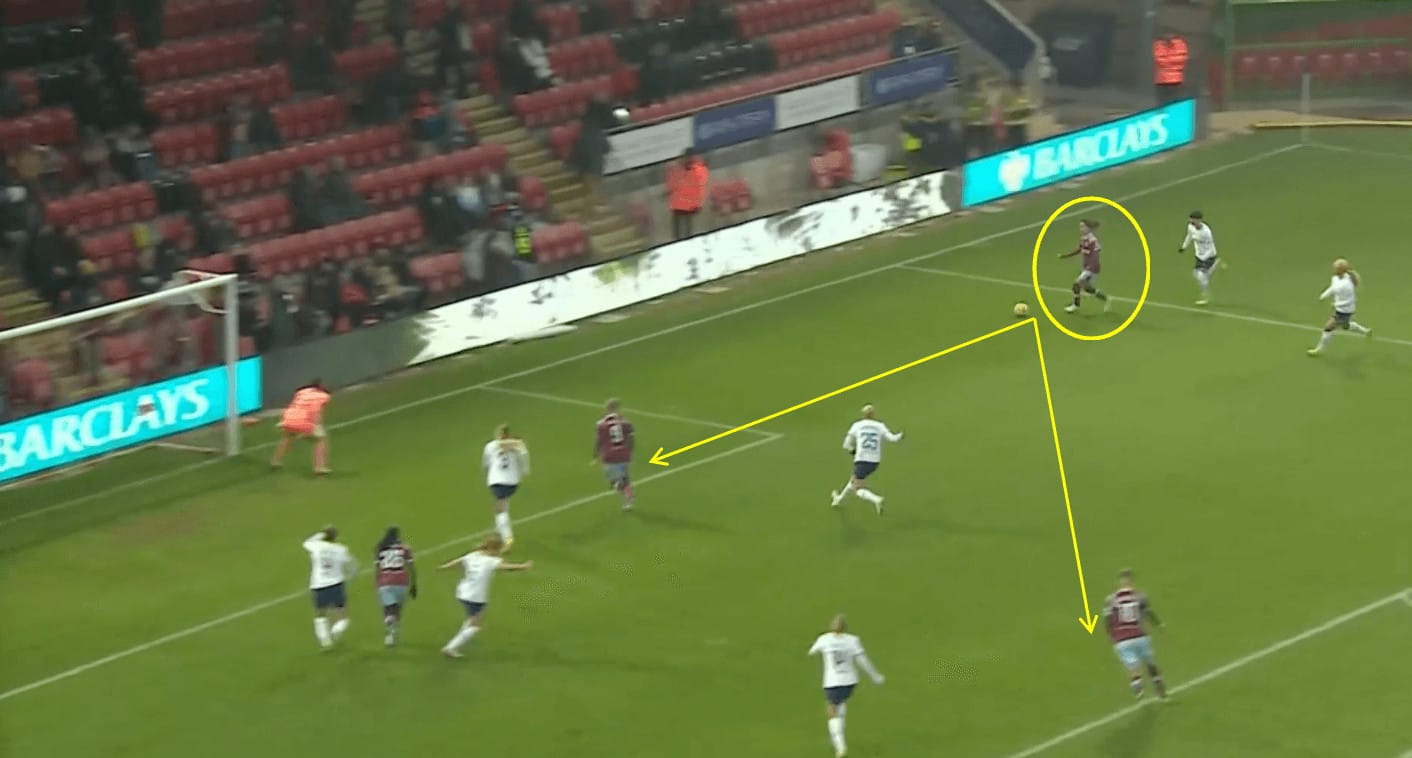
This is an excellent example of Shimizu’s attacking play. She makes some wonderful overlapping runs. As we can see, she can ghost in behind the Tottenham defensive line effectively. She gets into an excellent crossing position where she can aim a cross at the near post or pull the ball back to the edge of the area. On this occasion, she opts for the former, and the Spurs defence clears the ball, but Shimizu’s dynamic attacking play can create plenty of opportunities.
Gabby George – Manchester United
The final player in this analysis piece is new Manchester United recruit Gabby George. The Wythenshaw-born defender signed for her childhood club this summer following nine years at Everton. Usually a centre-back, George spent last season playing as a left wing-back for Everton under Brian Sørensen and has gone from strength to strength.
Honestly, it was somewhat baffling that she wasn’t included in the England squad throughout the season. While Sarina Wiegman continued to overlook her talents, Marc Skinner was impressed with her performances as he instructed Manchester United to meet George’s release clause over the summer.
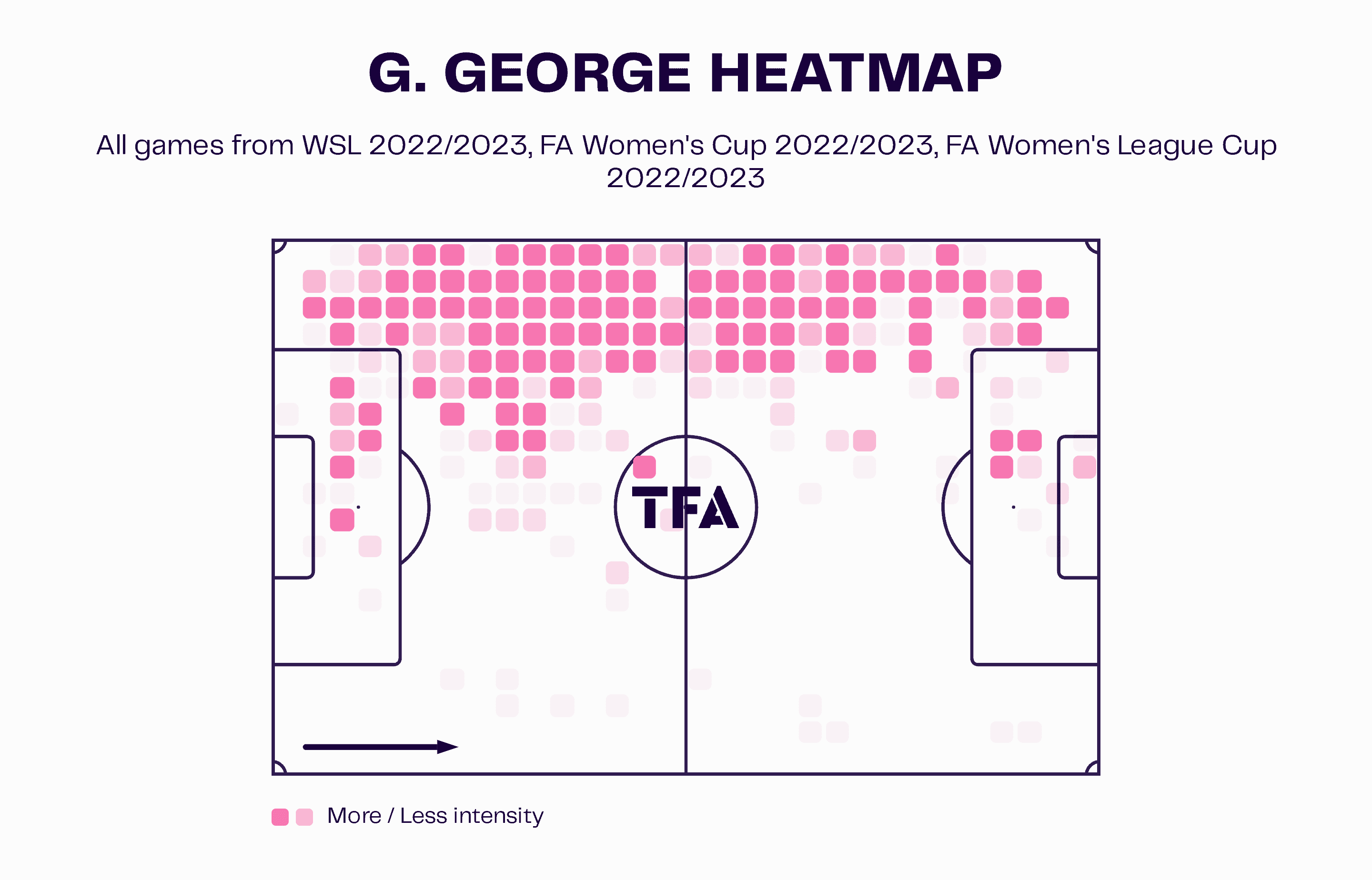
Gabby George is a very forward-thinking player. We can infer from the heatmap that she covers a vast amount of ground for her team. She tends to move a little more centrally during transitions from attack to defence, often so she can cut off passing lanes, providing her teammates time to move back into their defensive shape.
Regarding her attacking abilities, George is a positive player who constantly looks to make things happen in the opposition half. She frequently found herself in goalscoring positions last season, thanks to the freedom Sørensen’s 3-4-3 system allowed. She averaged 1.08 shots per 90, ranking her third when comparing left full-backs and wing-backs in the WSL. Only Chelsea’s Niamh Charles and Arsenal’s Katie McCabe took more shots per 90.
Moreover, George looked to play crosses into the penalty area, averaging 1.96 per 90, with an accuracy of 41.94%. She is incredibly reliable with the ball, choosing her passes carefully. During the 2022/23 season, she averaged 38.32 passes per 90 with an accuracy rate of 82.31%, which is very good when considering this includes long passes as well.

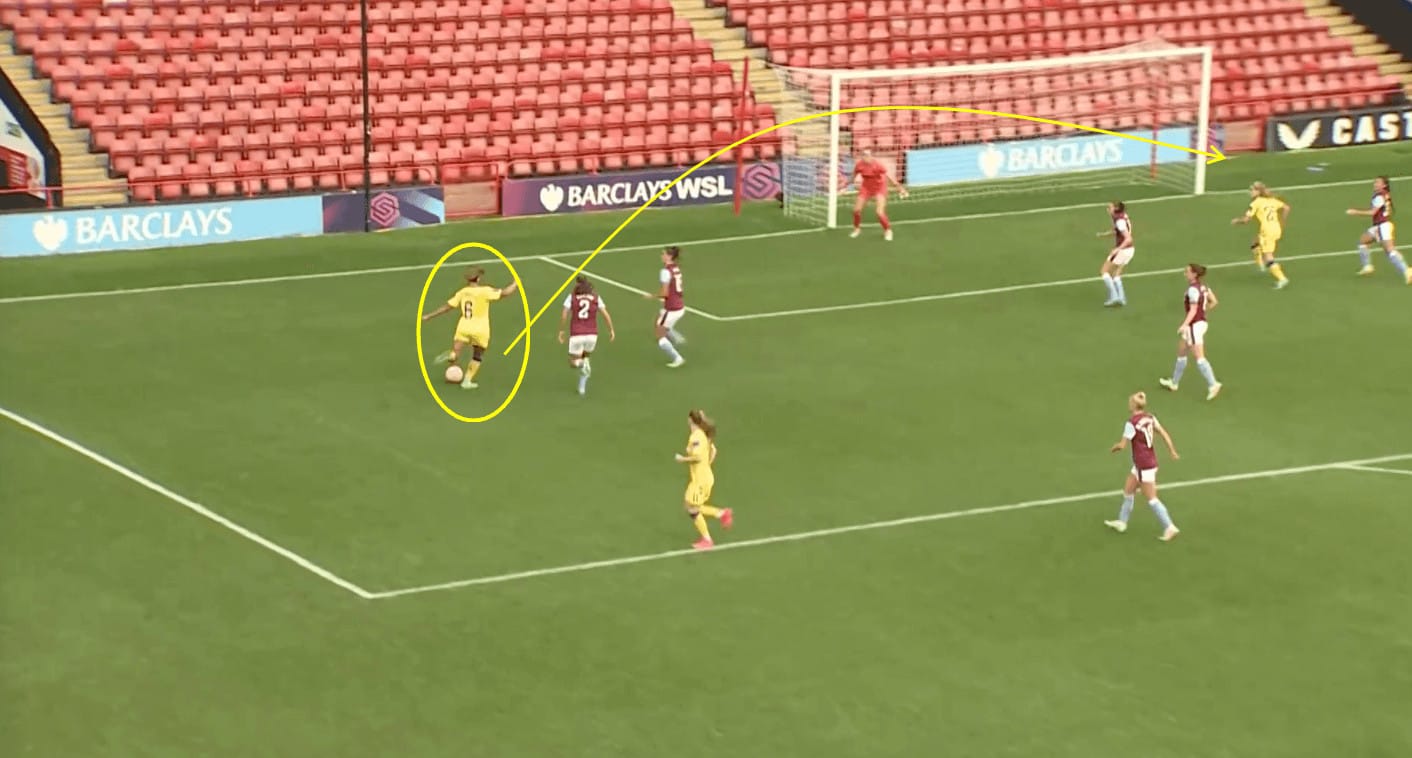
An excellent example of Gabby George’s positive attacking play can be seen above. She is quite narrow in this scenario, having drifted infield from the left wing. She then uses an explosive burst of acceleration to carry the ball into the penalty area, away from the defender. She then has the vision to lift a pass to the far post where a teammate can tap it into the net.
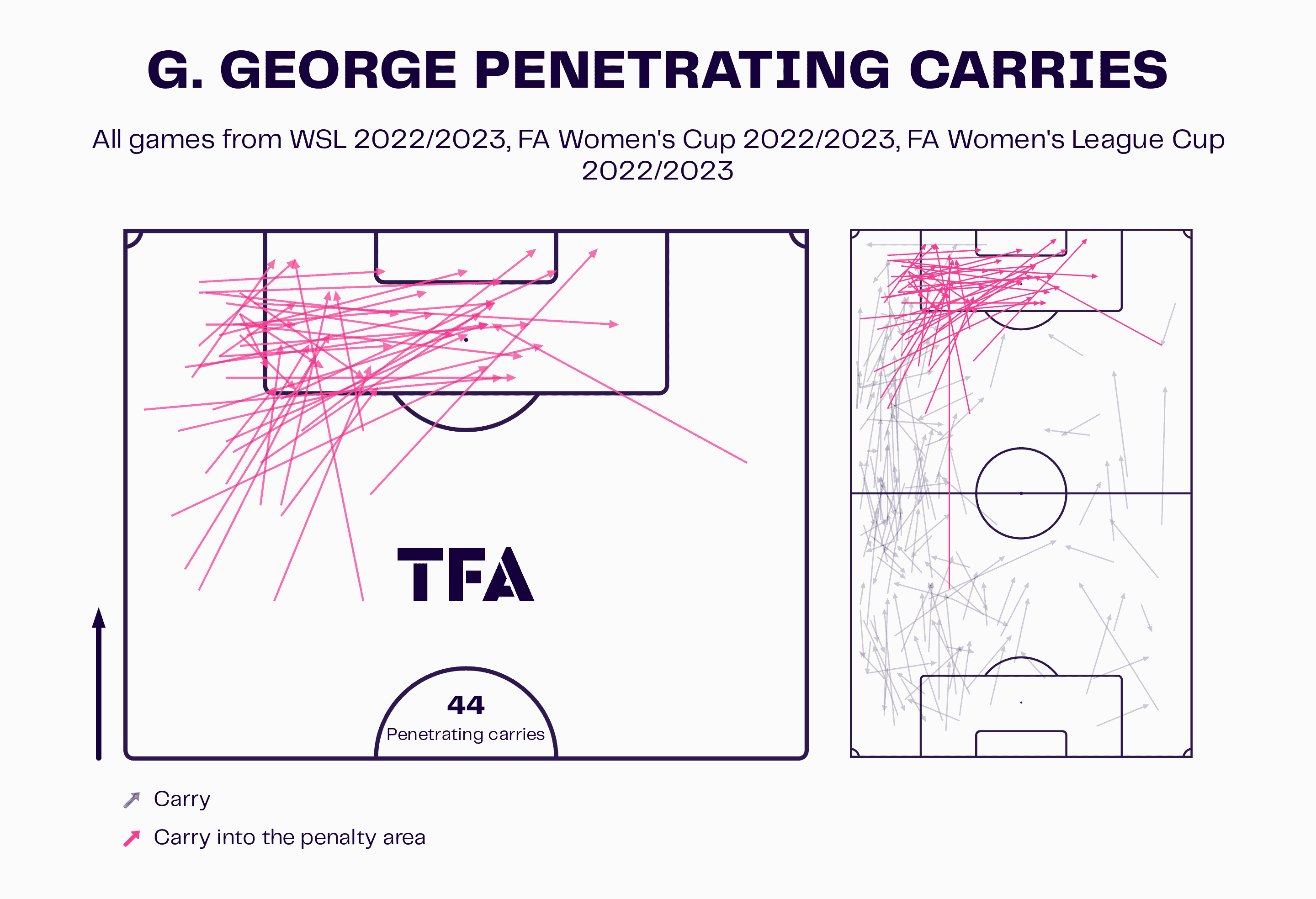
George loves to carry the ball forward; she made 3.23 dribbles per 90 last season, with a success rate of 58.82%. The data visual shows that she often carried the ball into the opposition penalty area. This adds an extra dimension to her team’s attack; George’s ability to dribble past opponents and push deep into the opposition’s half can catch defenders off guard and disrupt the opponent’s defensive structures, which can lead to goalscoring opportunities.
Additionally, her dribbling skills can draw defenders out of position; she will often attract the attention of opposing players, who have no option but to engage to try and close her down. This opens up space behind the defenders, which her teammates can exploit.
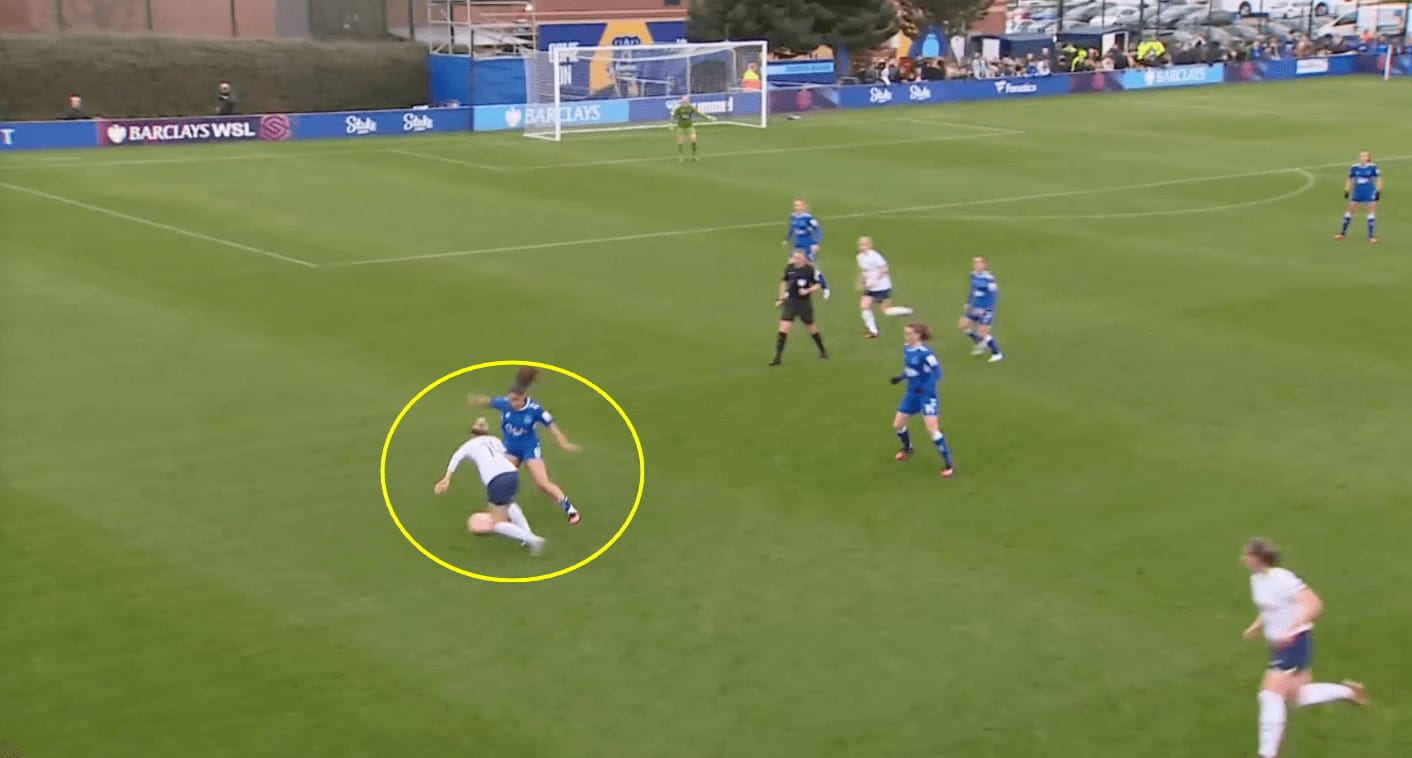
For all of Gabby George’s attacking qualities as a wing-back, she did not shirk her defensive responsibilities. Although she did struggle on some occasions, as we can see above, she was wrong-footed by her opponent, who had open space to run into. George does possess an excellent burst of pace and quickly recovers to put in a tackle.
During the 2022/23 campaign, she averaged 7.68 defensive duels per 90, with a success rate of 55.9%. Additionally, she made 4.19 interceptions per 90, which indicates she can read the game well to ensure she is in the right place to make valuable interceptions. The only genuine concern for Manchester United could be that she did average 9.44 losses per 90, with 41.2% being in her own half.
If Marc Skinner’s side are going to compete at the top of the table again, they will need their defenders to be reliable in possession in the defensive third. However, these numbers could be because she was playing the wing-back role and, therefore, charged with carrying the ball up the pitch, which meant there was a higher chance of her losing possession on occasion.
Seeing how she performs at Manchester United as Marc Skinner typically opts for a back four will be very interesting. This means we will either see her return to playing centrally or utilised as a full-back; either way, it places more defensive obligations on George.
Conclusion
This analysis has highlighted five under-the-radar players we believe are ones to watch out for in the upcoming WSL season. We have looked at how these players performed over the course of last season and shown why we believe they will make an impact in the 2023/24 season.
The league is full of unbelievable talent that stretches beyond the big names, and the recruitment over the summer has been excellent. With the new season about to kick off, it looks set to be the most competitive one yet.




Comments